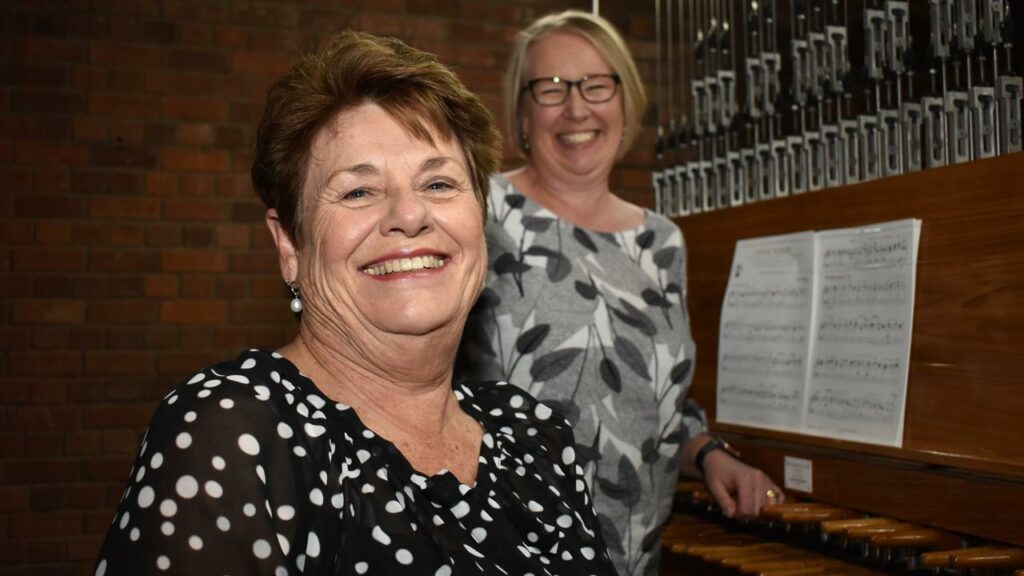For whom the bell tolls: 90 years of rural remembrance
Stephanie Gardiner |

Behind a set of heavy iron doors a narrow and winding staircase leads to a dark room where a little red clock ticks away on the wall.
This sparse space inside a towering war memorial in Bathurst, central western NSW, is home to rural Australia’s only carillon, the largest of all musical instruments.
On a mild autumn afternoon local musicians Denise Garland and Wendy Murphy practise duets, sending reveries from 47 bells up and over the wide country streets.
High above them one of the biggest bells in the tower is inscribed: “To the ever glorious memory of our fallen comrades. Greater love hath no man than this, that he lay down his life for his friends”.
Whenever Mrs Garland sits down to play, she thinks of the grandfather she never knew: Anthony Hicks, a World War I soldier and the carillon’s first custodian.
“I go up knowing my grandparents spent a lot of time here and had their heart right here in this building,” she tells AAP.
“It’s very special to me.”
Private Hicks was a young railway worker when he and his two brothers left their quiet country lives to fight on the Western Front. He was the only brother to survive and returned alone on a troopship in 1919.
During moments of terror and torment in the battlefields of Europe, Private Hicks and other local soldiers found solace in the pealing bells from churches and carillons. They wanted to bring the music home.
From the mid-1920s, Bathurst Diggers’ Club lobbied for a grand war memorial carillon and locals raised funds through carnivals, bake sales, dances and choir performances.
The bells were cast and inscribed in London and shipped to Australia, the largest weighing 1.5 tonnes. It was a costly endeavour as the world sank into the Great Depression.
“Bathurst had the ambition and courage to aim at a memorial entirely without utilitarian character – a singing tower, a pure work of art, musical and architectural,” the National Advocate newspaper reported before the carillon’s opening in 1933.
The last brick was laid on the memorial on the afternoon of April 24 that year and the first Anzac Day service held the next day. It was officially dedicated on Armistice Day.
In its 90 years, the carillon has become the feature of weekend recitals, Christmas performances and next weekend’s Festival of Bells, which draws carillonists and bellringers from around the country.
Its origin is never far from the minds of its three dedicated players: Jennifer Roberts, Mrs Garland and Mrs Murphy.
“I imagine those conversations when (the soldiers) came back; they’ve been in a different country, people dying all around them and they remember the bells,” Mrs Murphy says.
“They saw that beauty amongst battle. There’s blood sweat and tears amongst all of that brick and mortar.”
The carillon is one of thousands of unique war memorials in regional Australia, among cenotaphs, statues, lone pine trees and obelisks dotted across the landscape.
A statue of a soldier made from 100 layers of metal stands in Burleigh Heads, Queensland, made to mark the centenary of the Anzac Cove landings, while murals of diggers and Red Cross nurses adorn silos and water tanks in rural Victoria.
A statue of a homeless veteran sits at the Rockingham war memorial, south of Perth, depicting a man with his hand outstretched, a hat upturned in his lap.
The likeness, unveiled in 2021, was a collaboration between veterans Hayley Edwards and Laurie Drage and homelessness advocate Owen Farmer to capture the heartache some face when they return from duty.
“You serve your country and it’s the proudest moment in your entire life, the proudest moment of your family’s life … but that doesn’t mean your life is not forever affected,” says Ms Edwards, who is Rockingham’s deputy mayor.
Though days like Anzac Day often come with mixed emotions, Ms Edwards says memorials provide a sense of healing.
“With the homeless veterans statute or any memorial, I go and actually touch it and I feel very connected.”
More than 11,000 monuments make up the Australian War Memorial’s Places of Pride digital collection, telling the stories of memorials across the nation.
It allows all communities to be part of a national experience, the project’s head Terri-Anne Simmonds says.
Ms Simmonds says it is always poignant to see long honour rolls in small towns or repeated surnames indicating the deaths of several family members in one war.
“If it’s the butcher’s son that passed away, it’s a really personal, strong impact that people felt,” she says.
“That is a legacy that lives on and people connect with. It provides that opportunity to pause, particularly in the lead up to Anzac Day.”
In Bathurst, Mrs Garland sees playing the carillon as a continuation of her family’s six generations of community service.
“It’s part of bringing joy to people,” she says.
“Music is a part of wellbeing, to be able to feel at peace with all the things going on in our world and to have time to stop and think.”
AAP


